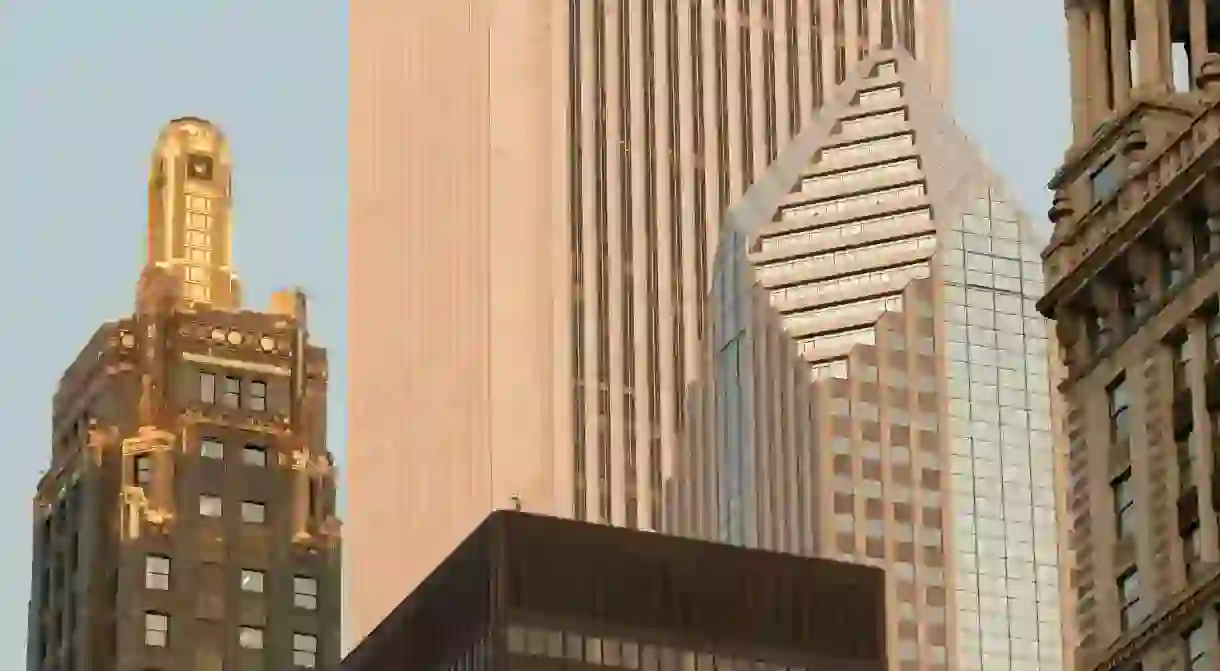An Art Deco Architecture Tour of Chicago

Set off on a walking tour of Chicago’s best Art Deco architecture, taking in geometric ornamentation and lavish lobbies that display the decadent spirit of the Windy City in the Roaring ’20s.
Chicago Board of Trade Building
Building

Bank of America Building
Building

From here, walk north on South LaSalle Street to the Bank of America Building, formerly known as the Field Building. Completed in 1934, it was the last major Chicago skyscraper erected before the Great Depression and World War II halted construction in the city. The building’s 45 stories are constructed from polished black granite, with decorative windows accented by aluminum spandrel panels (the pair of triangular spaces between an arch and the moulding above it).
One North LaSalle Building
Building

Continue north to West Madison Street, where South LaSalle becomes North LaSalle, and you’ll find the One North LaSalle Building. Designed by architects Vitzthum & Burns in 1930, it was the city’s tallest structure for 35 years and has a beautifully preserved grand lobby – another hallmark of Art Deco. Look up to the fifth floor and you’ll notice carved relief panels depicting René-Robert Cavelier, a French explorer and fur trader who traversed the Great Lakes region in the 17th century.
Riverside Plaza
Building

Walk west down West Madison Street, stopping on the bridge that arcs across the Chicago River. On the west bank you’ll see Riverside Plaza, the first Chicago building to incorporate a public plaza in its design. Once home to the Chicago Daily News, the building has a facade that pays tribute to eight historic figures from journalism – the names of Joseph Pulitzer, Benjamin Franklin and Joseph Medill (co-owner of the Chicago Tribune and mayor of Chicago during the Great Fire) are among those featured.
Civic Opera Building
Building

Directly opposite the Riverside Plaza you’ll spot the Civic Opera Building. Comprising a 45-story tower flanked by two 22-story wings, it looks like a giant throne overlooking the Chicago River. The building was envisioned by Samuel Insull, the wealthy co-founder of the country’s leading electrical companies, who wanted his opera house to embody “the spirit of a community which is still youthful and not much hampered by traditions.” The project took just 22 months to complete and its first opera, Verdi’s Aida, was performed six days after the stock market crash of 1929.
Merchandise Mart
Building

Next, stroll north, following North Upper Wacker as it curves around to the east. Stop between the Franklin Street and Wells Street bridges and gaze across the river at the Merchandise Mart. With 4 million square feet of floor space, it was the largest building in the world when it opened in 1930. On the ground level, huge bronze-framed windows hint at the building’s original purpose; it was formerly a wholesale warehouse for Marshall Field & Company department stores.
Century Tower
Building
For the next stop, follow the elevated train line down North Wells Street and turn left at West Lake Street to see Century Tower, which was built in 1930. Another Chicago landmark that once claimed the title of the world’s tallest skyscraper, it consists of a 20-story main building topped by an eight-story tower and a distinctive ziggurat.
Carbide and Carbon Building
Building

Follow East Wacker Place to Michigan Avenue to reach the lavish Carbide and Carbon Building. The building’s showstopping exterior is composed of black marble, green-tinted terracotta and gold leaf, and its spire is coated in a thin layer of 24-carat gold. Inside the Michigan Avenue entrance, a lobby made with Belgian marble and frosted glass creates a grand welcome.
Chicago Motor Club Building
Building
Just across the street on Wacker is the historic Chicago Motor Club Building, a slim 17-story tower that was erected at record-breaking speed – in just 234 days, including the demolition of the pre-existing building on the site. Peek inside and appreciate the original artwork by pioneering American muralist John Warner Norton – a two-story-high map of the USA.
333 North Michigan
Building

Head back to the riverfront to see 333 North Michigan, a long, narrow 1928 skyscraper with a base of polished marble and embellishments depicting Native Americans and pioneers at Fort Dearborn, a Chicago fort built in 1803.
Palmolive Building
Building

Finally, cross the DuSable Bridge and follow the Magnificent Mile until you reach the Palmolive Building at East Walton Place – another building by architects Holabird & Root (also responsible for the Chicago Board of Trade Building, 333 North Michigan and many other historic Art Deco landmarks in the city). One of the first skyscrapers built outside of the Loop, it’s a stunning example of the dramatic detail and beauty of the Art Deco architectural style.
This article is an updated version of a story created by Tim Marklew.













